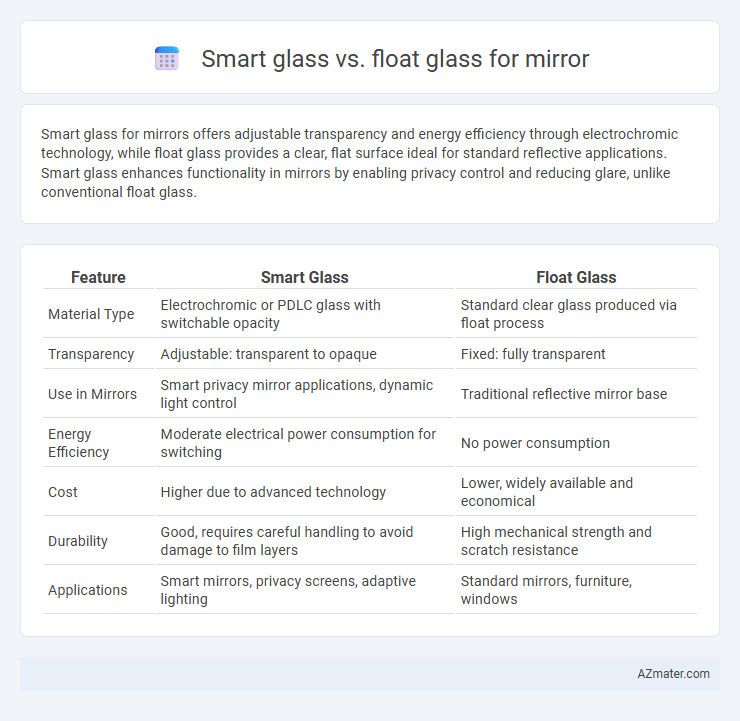Smart glass for mirrors offers adjustable transparency and energy efficiency through electrochromic technology, while float glass provides a clear, flat surface ideal for standard reflective applications. Smart glass enhances functionality in mirrors by enabling privacy control and reducing glare, unlike conventional float glass.
Table of Comparison
| Feature | Smart Glass | Float Glass |
|---|---|---|
| Material Type | Electrochromic or PDLC glass with switchable opacity | Standard clear glass produced via float process |
| Transparency | Adjustable: transparent to opaque | Fixed: fully transparent |
| Use in Mirrors | Smart privacy mirror applications, dynamic light control | Traditional reflective mirror base |
| Energy Efficiency | Moderate electrical power consumption for switching | No power consumption |
| Cost | Higher due to advanced technology | Lower, widely available and economical |
| Durability | Good, requires careful handling to avoid damage to film layers | High mechanical strength and scratch resistance |
| Applications | Smart mirrors, privacy screens, adaptive lighting | Standard mirrors, furniture, windows |
Introduction to Smart Glass and Float Glass
Smart glass incorporates electrochromic or thermochromic technology, allowing dynamic control over light transmission and privacy, making it ideal for modern mirror applications requiring functional versatility. Float glass, a flat and uniform glass produced by floating molten glass on molten metal, is commonly used as the fundamental substrate in mirror manufacturing due to its clarity and smooth surface. Comparing smart glass and float glass underscores smart glass's added interactive features versus float glass's basic yet essential structural qualities.
Key Differences Between Smart Glass and Float Glass
Smart glass offers dynamic light control and privacy features through electrochromic, photochromic, or thermochromic technologies, unlike float glass, which is a basic flat glass made by floating molten glass on a bed of molten metal without inherent light modulation properties. Float glass provides a smooth, uniform surface that serves as an ideal base for mirror coatings but lacks energy efficiency or adaptive transparency found in smart glass. The key differences include smart glass's ability to change opacity and enhance energy savings versus float glass's simplicity and widespread use as a substrate in mirror manufacturing.
How Smart Glass Works in Mirrors
Smart glass in mirrors operates using electrochromic or liquid crystal technologies that modulate light transmission when an electric current is applied, enabling dynamic control of transparency and opacity. This functionality allows smart mirrors to switch between clear reflective surfaces and opaque states for privacy, energy efficiency, or aesthetic purposes. In contrast, float glass provides a static reflective surface without any light modulation capabilities, making smart glass a superior choice for versatile, interactive mirror applications.
Manufacturing Process of Float Glass for Mirrors
Float glass manufacturing for mirrors involves melting raw materials like silica sand, soda ash, and limestone at high temperatures before floating the molten glass on a bed of molten tin to create a uniform thickness and smooth surface. This precise process results in high-quality, distortion-free glass essential for superior mirror reflection. Compared to smart glass, float glass offers consistent clarity and durability, making it the preferred base for mirrors before applying reflective coatings.
Energy Efficiency: Smart Glass vs Float Glass Mirrors
Smart glass mirrors significantly enhance energy efficiency by dynamically controlling light transmission and reducing heat gain or loss, unlike traditional float glass mirrors which allow constant thermal transfer. The electrochromic technology in smart glass adjusts opacity in response to electrical input, lowering HVAC demands and minimizing energy consumption. Float glass mirrors lack this adaptive capability, resulting in higher energy costs due to unchanged thermal properties.
Aesthetics and Design Flexibility
Smart glass offers dynamic opacity control and customizable tinting, enhancing mirror aesthetics with modern, sleek designs and seamless integration into contemporary interiors. Float glass, known for its smooth, uniform surface, provides classic mirror clarity and reflectivity but lacks the adaptive design flexibility of smart glass technologies. Designers prefer smart glass for innovative applications requiring variable privacy and lighting effects, whereas float glass remains a cost-effective choice for traditional, high-quality mirror production.
Durability and Maintenance Requirements
Smart glass offers enhanced durability compared to float glass when used in mirrors due to its impact-resistant and scratch-resistant coatings, reducing the likelihood of damage over time. Float glass mirrors typically require more frequent maintenance, such as polishing and cleaning to prevent surface degradation and scratches. Smart glass mirrors also benefit from self-cleaning or easy-to-clean surface technologies, minimizing upkeep efforts and extending their lifespan.
Cost Comparison: Smart Glass vs Float Glass Mirrors
Smart glass mirrors generally have a higher upfront cost compared to float glass mirrors due to the advanced technology and materials used for switchable transparency and energy efficiency. Float glass mirrors are more affordable and widely available, making them a cost-effective option for standard applications without dynamic light control. Maintenance and operational costs can be higher for smart glass mirrors because of the electronic components, whereas float glass mirrors require minimal upkeep, impacting long-term expenses.
Applications in Residential and Commercial Settings
Smart glass offers dynamic light control and privacy features ideal for residential and commercial mirrors, enhancing energy efficiency and user comfort. Float glass, known for its smooth surface and durability, remains a cost-effective choice for standard mirror applications in homes and offices. Smart glass mirrors are increasingly favored in luxury settings, while float glass mirrors dominate everyday functional uses.
Which Is Better? Choosing the Right Glass for Your Mirror
Smart glass offers dynamic opacity control, making it ideal for mirrors requiring privacy or adjustable transparency, while float glass provides a clear, cost-effective base with excellent optical clarity commonly used in standard mirrors. For applications prioritizing energy efficiency and modern functionality, smart glass delivers superior performance, but float glass remains the preferred choice for affordability and simplicity. Selecting the right glass depends on whether you value interactivity and technology or traditional clarity and budget.

Infographic: Smart glass vs Float glass for Mirror
 azmater.com
azmater.com